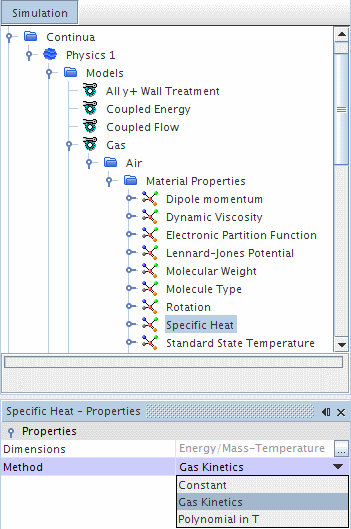Using the Gas Kinetics Method for Specific Heat
This method becomes available with single- and multi-component gases, together with the Ideal Gas, Constant Density, or Thermal Non-Equilibrium Ideal Gas models, or with any of the Real Gas models: Peng-Robinson, Redlich-Kwong, Soave-Redlich-Kwong, Modified Soave-Redlich-Kwong, and Van der Waals).

The specific heat of a gas consists of contributions from translational, rotational, vibrational and electronic energy [33]:
where:
- values are specific heats at constant pressure.
- values are specific heats at constant volume.
For each energy type, the contribution to the specific heat is calculated based on the associated partition function, through the following formula:
where:
- is energy of type .
- is (translational), (rotational), (vibrational), or (electronic)
- is the gas constant.
- is the temperature.
- is the partition function for energy of type i.
To determine the total specific heat, the partition function for each energy type must be specified. The combined translational and rotational energy can be simplified because:
- For the translational energy, the specific heat is effectively constant due to the small spacing between quantum energy levels.
- The rotational energy is assumed fully excited, since the spacing between quantum energy levels is negligible at all but cryogenic temperatures. Rotational energy is zero for monatomic molecules.
The combined translational-rotational specific heat is given as:
The partition function for electronic energy must be specified explicitly for this method. For polyatomic molecules, the partition function for vibrational energy must also be specified. These functions are both specified using a series of modes with characteristic temperature ( ) and degeneracy ( ). The partition function for each of these modes is defined as:
These degeneracies and characteristic temperatures can be found for various molecules in [29] and [32]. For N2, O2, NO, N, and O, these values are in the standard material database provided as part of STAR-CCM+.